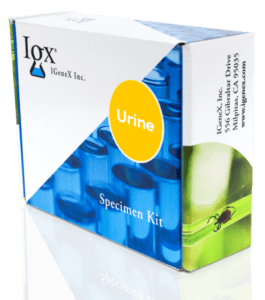- Improved sensitivity because it includes Lyme Borreliae-specific antigens from multiple strains and species.
- Improved specificity because pure proteins are sprayed at specific positions on the blot.
- Superior at all stages of Lyme disease. ImmunoBlots can be positive whereas ELISA and IFA tests can be negative at early and late stages when antibody levels are very low.
- More sensitive and specific than other qualitative tests, such as the ELISA, IFA, and traditional Western Blots.
Test
Lyme ImmunoBlot IgM
$225.00
The Lyme ImmunoBlot is a qualitative immunoassay in which antibodies specific to the B. burgdorferi antigens on a membrane strip are visualized. It is a qualitative test and is more sensitive and specific than the ELISA, IFA, and traditional Western Blot tests. In early or late stage Lyme, when antibody levels are very low, the ImmunoBlot can be positive, whereas ELISA and IFA tests can be negative.
The Lyme ImmunoBlot IgM is a very sensitive indicator of exposure to B. burgdorferi. It may be positive as early as two weeks after a tick bite and will usually remain positive for six to eight weeks after initial exposure; in some patients it can remain positive for even longer. Re-exposure will also cause this test to be positive for a brief period of time.
This test is recommended to be performed at least two weeks after possible exposure. The Lyme ImmunoBlot IgM must be performed on any sample with positive or equivocal result for Lyme IgG/IgM antibody serology or Lyme IgG/IgA/IgM IFA, and should ideally be run alongside the IgG ImmunoBlot.
Principle
The Lyme ImmunoBlot assay is based upon an antigen-antibody complex formation in the following steps:
- Binding of anti-Borrelia specific antibodies in human serum to the ImmunoBlot strip. The ImmunoBlot strip is a membrane strip with fixed B. burgdorferi recombinant antigens on it.
- Binding of enzyme labeled anti-human IgG or IgM antibodies to the human anti Borrelia antibodies bound to fixed B. burgdorferi antigens on the membrane.
- Reaction with BCIP/NBT, a chromogenic substrate with bound antibodies on the strip. A dark purple colored precipitate (band) develops on the antigen-antibody complexes.
Tube / Specimen Requirements
1 SST/ minimum volume 0.5mL serum
CPT Code(s)
0041U
Sample Report
View
ImmunoBlot
Available in New YorkYes
IgM (IGeneX Criteria)
Positive: If two or more of the following bands are present: 23, 31, 34, 39 and 41 kDa.
Negative: Any other profile.
IgM (CDC Criteria)
Positive: If two or more of the following bands are present: 23, 39 and 41kDa.
Negative: Any other profile.
- Patients with other spirochetal disease and/or who test positive for rheumatoid factor or Epstein Barr virus may have cross-reacting antibodies and may have a positive result for 31, 41, and/or 83 kDa antigens.
- Positive results for 31 kDa antigens may be present after Lyme vaccination in uninfected persons.
- A negative ImmunoBlot does not exclude the possibility of infection with B. burgdorferi.
- IGeneX interpretation is based on internal validation studies.
- The results of this test must be interpreted in relation to patient’s clinical history, epidemiological data, stages of disease, clinical symptoms or other laboratory results.
- The presence of bands 23-25, 31, 34, 39 or 83-93kDa as indeterminate or presence of only one of these bands in a negative report may indicate clinical significance. Therefore, we recommend testing with another method and/or retesting in 4-6 weeks.
Related Tests
GET STARTED TODAY!
The first step in getting tested with IGeneX is to order a collection kit. Choose between a Blood, Urine, or Miscellaneous kit.
WHY IGENEX FOR TICK-BORNE DISEASE TESTING?

- CLIA certified in all 50 states
- Long track record of success since 1991
- Offers testing that is nearly twice as accurate as CDC recommended tests
- Tests for all major tick-borne illnesses, including Lyme disease, TBRF, Babesia, Bartonella, and Rickettsia
- Utilizes comprehensive testing methods such as PCR, ImmunoBlots, IgXSpot and FISH
- Has become a nationwide leader in COVID-19 testing due to a relentless focus on customer satisfaction









